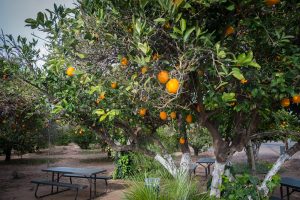The question of the headline, which was the title for the talks I gave last week in Phoenix was, I admit, a little cheeky. I’m just some schlub from New Mexico with an academic title and a book. That doesn’t mean I know the answer to the question. But to the extent I have an answer, it is this – Arizona (and lots of other places) probably don’t need as much water as they think.

Citrus groves, Mesa Arizona
Arizona gets some criticism in my book – for some holes in its groundwater management laws, and for its sometimes pugilistic approach to water management with its neighbors. But one of the things I very much like about Arizona is that both of those things arose out of a very deep and serious ongoing community conversation about water. I’ve seen this before, but I was really struck again on this visit by the passion and thoughtful conversations about water in Arizona.
My “probably not as much water as you think” argument is based on data on “decoupling” in Arizona and elsewhere – the way populations and economies have been growing in recent decades while water use has not. This is true across most geographies and water use categories in the United States, and for my talks I pulled together a few Arizona datasets that illustrates the phenomenon there:
- overall, according to USGS data, total water use in Arizona peaked in 1980 and has been declining since, even as population has more than doubled.
- A big part of that change involved the transition from an agricultural economy to an urban economy in central Arizona. But even in the municipal sector alone, you can see decoupling happening. In Phoenix, total water use (not per capita, total) peaked in 2002. Since then, water use has declined by 15 percent, while population has gone up 14 percent.
- On some Arizona’s most important agricultural land, in Yuma County (that’s where that lettuce you just ate came from), water use is down by 30 percent from its mid-’70s peak, while farm productivity is up. Adjusted for inflation, crop revenue per acre foot of water has doubled.
As I argued in this piece I wrote last year, decoupling of water use from economic activity and population growth is a critical feature of the contemporary water policy landscape. If we can incorporate it in our policy discussions, it will provide crucial breathing room for the kind of collaborative arrangements I argue for in my book.
Part of my answer to our cheeky talk title question is that it’s for Arizonans to decide how much water they need. But successful decoupling means they have a lot more space to do it than some of the conflict-ridden discussions within the state might suggest.
